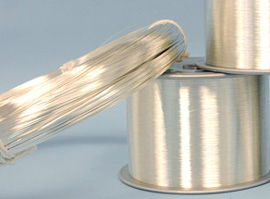
Solving a Materials Problem
In design engineering, materials are always a tradeoff. Steels deliver strength but can’t carry current efficiently. Pure copper carries current beautifully but deforms under stress. Every alloy family moves the needle one way or the other, but rarely do they combine both extremes. Beryllium-copper (BeCu) is the exception. By adding a small percentage of beryllium to copper, manufacturers created an alloy that doesn’t force engineers to compromise. It offers the strength of hardened steels alongside the conductivity, corrosion resistance, and reliability expected from copper.
That unique balance explains why BeCu appears in places where reliability is non-negotiable: connectors that must withstand contact forces for decades. These tools must not spark in explosive environments or cryogenic hardware where failure would be catastrophic. The story of BeCu is not a collection of properties; it’s a demonstration of how one alloy solved an unsolved problem in materials science.
Strength and Endurance in One Package
The most striking quality of BeCu is its ability to achieve steel-like strength without losing its copper base. Through precipitation hardening, high-strength grades such as C17200 routinely exceed 200 ksi in tensile strength — levels usually associated with high-grade steels. Yet unlike steel, this strength doesn’t come at the cost of ductility or toughness. BeCu parts resist cracking under shock, bending, or vibration, which makes them invaluable in dynamic applications like aircraft bearings or precision springs.
But strength alone would not set BeCu apart. What engineers value is endurance. Over millions of cycles, BeCu springs and contact beams maintain their load without fatigue failures. Where other copper alloys quickly lose elasticity, BeCu remains resilient, even under repeated bending and vibration. In connectors, this translates to years of reliable contact pressure, minimizing maintenance and preventing costly downtime. For designers, it means the difference between a component that performs in the lab and one that survives in the field.
Conductivity Where it Matters
If BeCu only delivered strength, it would simply be another high-performance copper alloy. What makes it transformative is that it retains enough electrical and thermal conductivity to function in circuits, relays, and power systems. High-strength grades offer around 20–25% of pure copper’s conductivity, which is sufficient for signal-carrying connectors where mechanical durability is more important than peak conductivity. High-conductivity grades reach 45–65%, striking the balance needed for power connectors, welding electrodes, or plastic injection molds where both current flow and structural integrity are critical.
This balance between mechanical and electrical performance means BeCu can often replace assemblies of multiple materials. Instead of pairing a steel spring with a separate copper conductor, engineers can design a single BeCu part that does both jobs. The result is lighter assemblies, simpler manufacturing, and fewer points of failure, all direct benefits that go beyond abstract property charts.
Stability Across Temperatures and Environments
A connector or spring is only as good as its performance under real-world conditions. Many alloys lose strength as heat builds or become brittle when temperatures plunge. BeCu resists both extremes. At cryogenic temperatures, it shows no brittle transition and even gains strength and ductility, making it invaluable in liquid hydrogen and oxygen systems. At the other end, it maintains tensile properties well into the 200–400°C range, depending on grade, outlasting many alternatives in hot industrial settings.
Equally important is its stability over time. Stress relaxation, the gradual loss of contact force under load, is a common failure point for connectors. Pure copper relaxes quickly, causing signal loss or overheating. BeCu, by contrast, resists relaxation due to its stable, precipitation-hardened microstructure. This is why Beryllium copper connectors are trusted in aerospace and telecommunications: once installed, they continue to perform through years of temperature cycles and mechanical stress.
Corrosion resistance further reinforces this reliability. Unlike steels that suffer from hydrogen embrittlement or chloride stress-corrosion cracking, BeCu is immune to both. In seawater, oil-field equipment, or sour-gas environments, it stands up where other alloys fail. For engineers designing in harsh or regulated environments, that immunity is more than a property — it’s peace of mind.
Safety and Responsibility in Use
Beryllium copper wire is also chosen when safety is paramount. Because it is non-magnetic, it can be used around sensitive instruments or in medical devices without disturbing magnetic fields. Its non-sparking behavior makes it essential for tools in oil refineries, grain silos, or chemical plants, where a single spark could trigger disaster. These aren’t secondary benefits; they are critical reasons entire industries mandate BeCu in their standards.
However, the same element that gives BeCu its unique properties — beryllium — also requires careful handling during manufacturing. Dust and fumes from machining can be hazardous if not controlled, which is why regulatory standards strictly limit occupational exposure. Finished BeCu products are safe, but responsible production means following those standards closely. This dual reality reinforces BeCu’s place as a high-performance alloy: its benefits are unmatched, but they come with a responsibility to handle it with respect.
Beryllium Copper Wire: The Alloy That Eliminates Compromise
Beryllium-copper stands apart because it solves a fundamental problem in materials engineering. It delivers the strength of steel and the conductivity of copper in a single alloy, then layers on resistance to fatigue, stress relaxation, corrosion, and temperature extremes. It operates in hazardous, magnetically sensitive, and cryogenic environments where alternatives cannot.
That’s why engineers keep turning to BeCu. It doesn’t just offer properties on a chart; it eliminates compromises that limit other materials. In doing so, it allows designers to simplify systems, extend service life, and trust their components under conditions where failure isn’t an option.

 Technical Data
Technical Data


